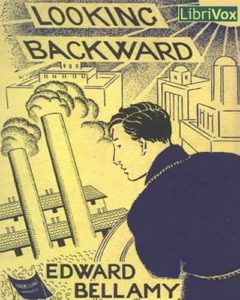Bellamy and Morris
Peter Harper October 2015In 1887 the American author Edward Bellamy wrote a Utopian novel called Looking Backward. It was critically reviewed by William Morris in 1889. By 1890 Morris had written his own Utopian novel, News from Nowhere, as a kind of riposte.
In some respects these represent two poles of Radical Technology, and perhaps we can learn much from the contrasts.
 Of the two, I read News from Nowhere (NFN) first, in my late 20s, when the concepts of Alternative Technology were congealing. Realising that NFN was in some sense a reaction to Looking Backward (LB), I felt compelled to read this too. Both are still in print.
Of the two, I read News from Nowhere (NFN) first, in my late 20s, when the concepts of Alternative Technology were congealing. Realising that NFN was in some sense a reaction to Looking Backward (LB), I felt compelled to read this too. Both are still in print.
At that time I strongly shared Morris’s critical Arcadian viewof Bellamy’s urban, industrial, high-tech vision. I viewed ‘what has come to pass’ as a logical extension of Bellamy’s approach, and thought only a kind of de-industrialised culture could be both sustainable and convivial. Forty years later I am inclined to think that Morris was largely mistaken, and that Bellamy was closer to the mark. I am certainly not alone in this shift, and it is worth asking why ‘we’ have altered our perspective.
Of course NFN is inspiring and beautifully written. But as a blueprint for a potential alternative society is bears comparison with those drawings by M.C. Escher, of extraordinary perspectives that cannot be realised in three dimensions. I came to this view partly through the process of trying to live out the kind of life portrayed, but also through many other life experiences. I came to regard it as a hypocritical ‘bourgeois’ illusion (as many Marxist colleagues said at the time, although I don’t think I share all their reasoning; and they haven’t done so well themselves, when all’s said and done).
Let me give an example of what we might call ‘the Arcadian illusion’. A few years ago the V&A mounted an exhibition dedicated to the Arts and Crafts movement, largely inspired by the work of Morris and his circle. The movement is justly regarded as a significant element in the history of art, and is still influential. But the point of it was not Art, but to counter the drab, vulgar and poorly-made products of the growing industrial system. And indeed, the stuff on display in the exhibition was beautifully designed and skilfully made. Gorgeous!
Morris wanted us all to have such things. Probably his most-quoted line is
“Have nothing in your house that you do not know to be useful, or believe to be beautiful.” And domestically I still try to follow this rule of thumb.
But as we continued to walk around the exhibition, it gradually dawned on us that this degree of craft production was completely impossible to generalise. You could only have it if you were rich, certainly in the early 20th century. The Arts and Crafts enthusiasts were rich, and could easily indulge an illusion that craft items were available to all.
Of course it was true then, and even more now, that industrial production generates a vast quantity of crass tat. It is also true that modern middle-income households can afford craft items; they are available and indeed have a certain cachet. Many middle-class households are bursting with hand-made antiques, jewellery, paintings and other objets d’art.
But the point I am making is that such items are affordable precisely because the industrial system is so efficient, and middle-class people have done well out of it. Their essential needs are cheaply provided, and they have enough surplus for discretionary spending on scarce ‘positional’ goods. In fact of course, the hand-made has become a marker of status and success. Old houses with quirky features, in quirky places, are a particular case in point. It is one of the clearest markers of the class divide, that the middle-class prefer to live in a dwelling different from all others, while the ‘lower classes’ prefer one that is the same as all the others. Nostra culpa!
The industrial system has a hard time mimicking quirky one-offs. Instead it generates enormous ranges of easily-reproduced variations that do not fool the discriminating, but help lower-income (i.e. most) people to use artefacts for display, as the rich do. Thus the fetishism of commodities has become democratised – although the fastidious can pretend they are not subject to its influence.
 Morris’s legacy is at the top end:haute couture, Savile Row, the jewellers of Bond Street, the Persian carpets, the Art Galleries, those exquisite ‘heirloom’ watches. Bellamy’s legacy is the Bauhaus and its widespread influence in industrial and product design. Today we might say it’s IKEA. Clever, low-cost, tasteful design.
Morris’s legacy is at the top end:haute couture, Savile Row, the jewellers of Bond Street, the Persian carpets, the Art Galleries, those exquisite ‘heirloom’ watches. Bellamy’s legacy is the Bauhaus and its widespread influence in industrial and product design. Today we might say it’s IKEA. Clever, low-cost, tasteful design.
Where does RT sit here? I cannot see any alternative to the generation of the essentials by mass-industrial means. Housing, transport, energy, food, communications, functional household machinery, medicine. Of course it is always possible to use less, and in some cases there can be substitutions at a craft level, for some people some of the time. A large proportion of the broad ‘degrowth’ effort has gone in this direction. But fundamentally the task is to render industrial production and consumption both convivial and sustainable.
That is what Bellamy thought possible, and I suggest it is our task to realise it.
Perhaps, however, we still need to address the dream of being able to have the best of both worlds: effortless comfort and security along with hand-made particularity. Curiously, the best attempt I have found to picture this is not by any literary or philosophical theorist but as a bandedessinee in the pages of a children’s magazine.
The illustrator Frank Hampson created the Dan Dare space adventures in the pages of the newly-launched Eagle in 1950. The very first story, spanning 18 months of weekly instalments, envisaged (among many other things) a culture of human-like aliens in the southern hemisphere of Venus that came close to solving the Bellamy/Morris conundrum. The hero, Dan Dare, crash-lands in the middle of a city completely devoid of people. He is baffled., What on earth is it for? The city is run entirely by industrial machines producing all necessities in food, energy, materials and so on. But for whom? Dare discovers that the goods are transported through underground tunnels to the places where the real people live, in charming small settlements, in modest houses bereft of clutter and equipment. They live Morrisian lives, dedicated to family and friends, conversation, nature, the arts-and-crafts, and scientific enquiry.
The key here is that, although it looks like a vindication of Morris’s vision, it is actually closer to Bellamy’s in that the whole thing is supported by a fully-functioning industrial system – one that has become so efficient it needs no human labour to operate. This is in fact a fully modern dream – that one day, robots will provide all we need, and we will be free to do whatever we like. But of course many of the rich have this right now: they have no need to work, and can already do what they like, supported by powerful industrial technology operated by ‘robots’, both human and otherwise. Note that Capek’s original term robot means simply ‘worker’ in Czech.
Curiously, it is not the simply rich that have most benefitted from the present dispensation. In my limited experience of the seriously rich, they are as viciously consumed by the inner worms of greed, jealousy, and hopeless striving as any other part of society. Paradoxically it is the Bohemian bourgeoisie, among them the fiercest critics of Modernity, who have ended up with the cream. Free from the treadmills of MORE, they can pick and choose, and have a vast infrastructure at their disposal to provide them with whatever they want at unbelievably low cost. They are the modern equivalent of the mediaeval aristocracy, just a few percent of the population, for whom everybody else is working.
As an aside, it is pertinent to note that Thomas More’s original Utopia was based on egalitarian and what have come to be called ‘intrinsic’ values, but was dependent on a class of slaves considered to be outside the frame of true humanity. Today we would see this as a fatal flaw. The Venusians in the story, and modern industrial humans, overcome it by the use of artificial energy and advanced mechanical operations to replace the ‘slaves’.
From an RT perspective however, we can see what might have gone wrong. Hampson’s Venusians are in fact observing a Limits to Growth model and ethic; they know what is physically Enough, and they have tuned their culture to it. It is technically advanced and fully industrial, but cleverly managed in order to optimise fundamental ‘intrinsic’ values. And (as far as we can see) it is physically sustainable.
In our real world this is not what happens. Instead, a large majority opt for ‘extrinsic’ material-based values and use the industrial system to maximise these. Unfortunately this appears to provide neither deep satisfaction nor long-term physical sustainability.
The puzzle remains: can you reconcile an industrial culture with high quality of life and physical sustainability? It looks technically possible, but is it humanly possible?
